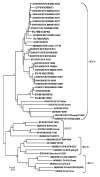Enteroviruses in patients with acute encephalitis, uttar pradesh, India
- PMID: 19193277
- PMCID: PMC2657625
- DOI: 10.3201/eid1502.080865
Enteroviruses in patients with acute encephalitis, uttar pradesh, India
Abstract
An outbreak of viral encephalitis occurred in northern India in 2006. Attempts to identify an etiologic agent in cerebrospinal fluid by using reverse transcription-PCR showed positivity to enterovirus (EV) in 66 (21.6%) of 306 patients. Sequencing and phylogenetic analyses of PCR products from 59 (89.3%) of 66 specimens showed similarity with EV-89 and EV-76 sequences.
Figures


References
-
- Sapkal GN, Wairagkar NS, Ayachit VM, Bondre VP, Gore MM. Detection and isolation of Japanese encephalitis virus from blood clots collected during the acute phase of infection. Am J Trop Med Hyg. 2007;77:1139–45. - PubMed
-
- Pallansch MA, Roos RP. Enteroviruses: polioviruses, coxsackieviruses, echoviruses, and newer enteroviruses. In: Fields virology, 5th ed. Knipe DM, Howley PM, Griffin DE, Lamb RA, Martin MA, Roizman B, et al., editors. Philadelphia: Lippincott Williams & Wilkins; 2006. p. 839–94.
Publication types
MeSH terms
Substances
LinkOut - more resources
Full Text Sources
